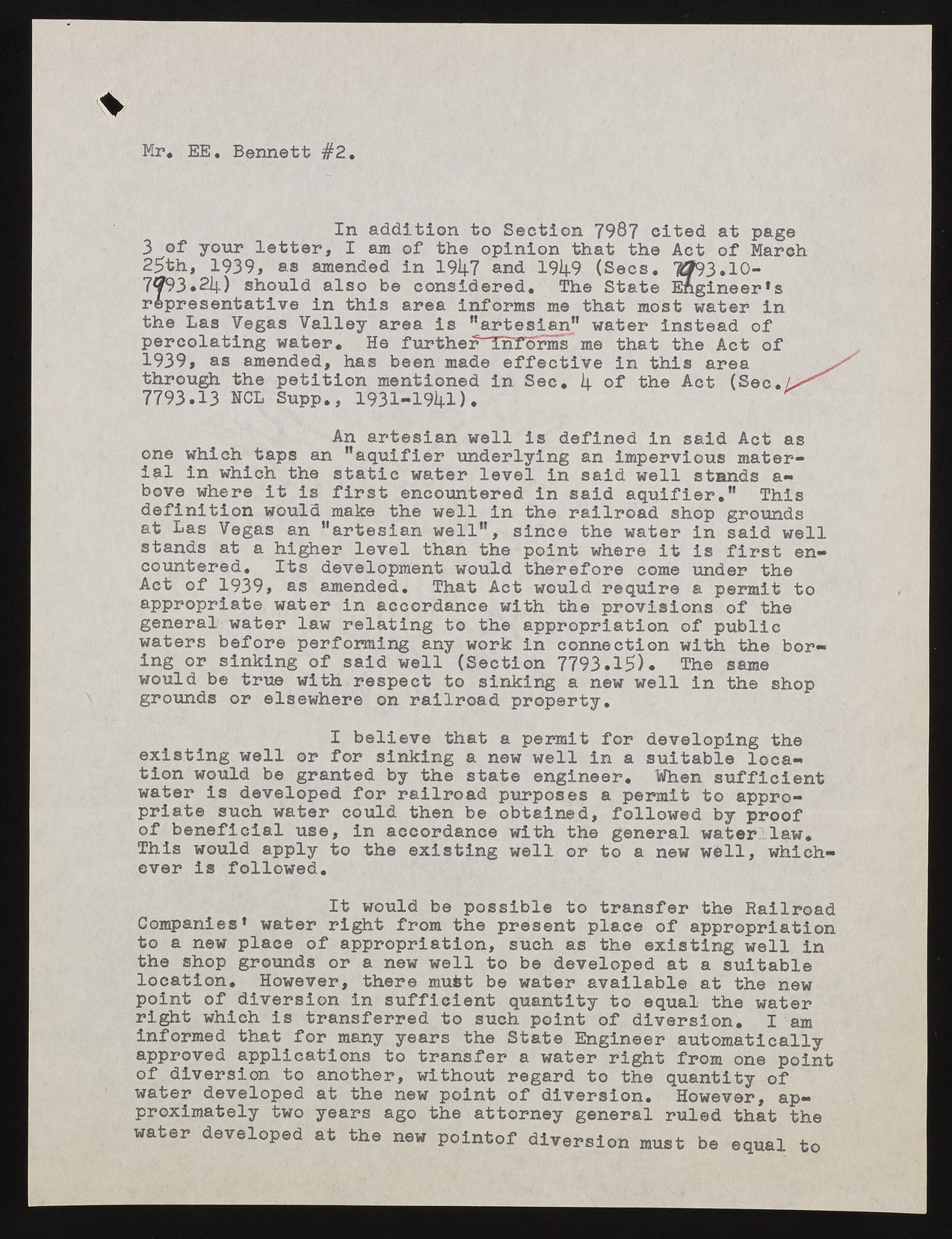Copyright & Fair-use Agreement
UNLV Special Collections provides copies of materials to facilitate private study, scholarship, or research. Material not in the public domain may be used according to fair use of copyrighted materials as defined by copyright law. Please cite us.
Please note that UNLV may not own the copyright to these materials and cannot provide permission to publish or distribute materials when UNLV is not the copyright holder. The user is solely responsible for determining the copyright status of materials and obtaining permission to use material from the copyright holder and for determining whether any permissions relating to any other rights are necessary for the intended use, and for obtaining all required permissions beyond that allowed by fair use.
Read more about our reproduction and use policy.
I agree.Information
Digital ID
Permalink
Details
More Info
Rights
Digital Provenance
Publisher
Transcription
Mr* EE. Bennett #2 In addition to Section 3 of your letter, I am of the opinion th a7t9 87t hee iAtcetd oaft Mpaargec h 27(57t9h3,.2 11+)9 39s,h ouasl d amalesnod edb e inc on19s1i+d7 eraendd. 191T+h9e (SSteacst,e E'jjn'fg9i3.n1e0e-r ’s representative in this area informs me that most water in the Las Vegas Valley area is ’’artesian” water instead of p1e93r9c,o laast inamge nwdaetde,r . hasH e bfeuernt hmeafd~eT neTfof5eS5cst imvoe ithna tt hitsh e aArceta of through the petition mentioned in Sec. 1+ of the Act (S ec 7793.13 NCL Supp., 1931-191+1). one which taps anA n’’ aqauritfeiseira nu wnedlelr lyisi ngd efainn eidm peirnv isoauisd mAactt erasibaolv e iwnh ewrhei chit thise fsitrastti c ewnactoeurnt elreevdel ini n sasiadi d awqeulilf iestra.n” ds Thai-s definition would make the well in the railroad shop grounds astt aLnadss Vate gaas hiagnh e’’ra rlteevseila n twheanl l”th, e spionicnet twhhe erwea teirt iisn fsiarisdt weelnlcountered. Its development would therefore come under the Aacptp roopfr i1a9t39e, waats era meinnd eadc.c ordTahnact e Awcti twh outhled rperqouviisrieo nas peorfm itth eto general water law relating to the appropriation of public wiantge rosr bseifnokrien gp eorf fosramiidn gwe laln y (wSoerckt iionn c77o9n3n.e1c5t)i.o n wTihet h satmhee borwould be true with respect to sinking a new well in the shop grounds or elsewhere on railroad property. existing well or If orb elsiienvkei ngt haa t neaw pweerlmli t info ra dsueivtealbolpei ngl octhaewtaitoenr w oius ldd evbee logpreadnt efdo r byr aitlher oasdt apteu rpeonsgeisn eear .p erWmhiet n tos ufafpipcrioent priate such water could then be obtained, followed by proof Tohfi sb ewnoeuflidc iaalp pulsye ,t o inth ea cceoxridsatnicneg wweiltlh otrh e tog ean enraelw wwbaltle,r wlhawi*c hever is followed. Companies* water rIti ghwto ulfdr obme thpeo sspirbelsee ntt o pltarcaen sfoefr apthper oRpariilartoiaodn to a new place of appropriation, such as the existing well in the shop grounds or a new well to be developed at a suitable plooicnatt ioonf. diHvoewresvieorn, int hesruef fmiucfieet ntb e qwuaatnetri tya vatoi laebqluea l att het hew atneerw right whieh is transferred to such point of diversion. I am informed that for many years the State Engineer automatically aofp prdiovveerds iaopnp litco atainoontsh ert,o wtirtahnosufte r rea gwaartde rt o ritghhe t qfuranotmi toyne ofpoint wpartoexri madteevleyl optewod yaet artsh e angoe w tpheo inatt toorf nedyi vegresnieorna.l rHuolweedv etrh,a t apthe water developed at the new pointof diversion must be equal to

